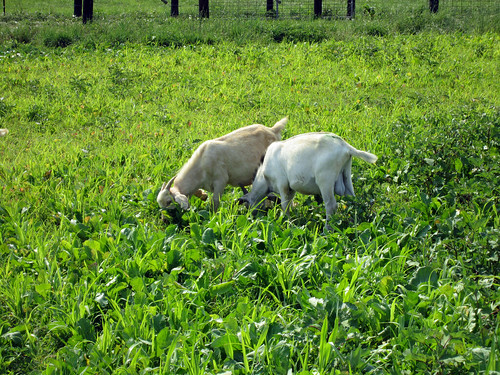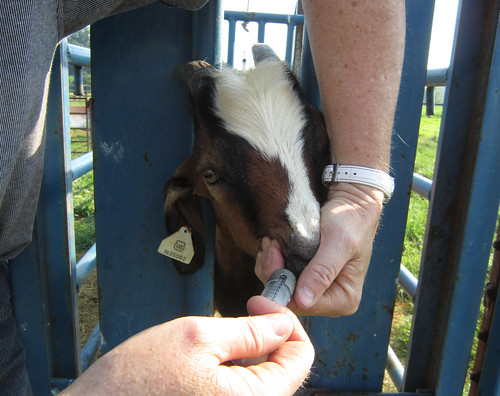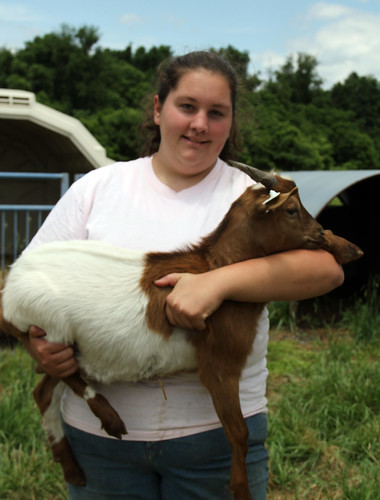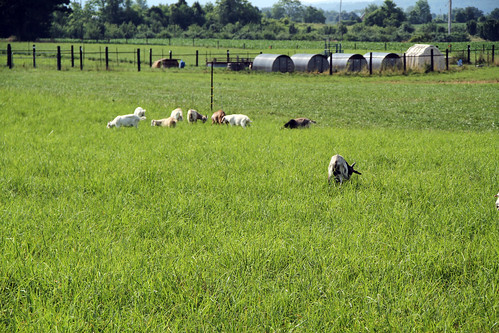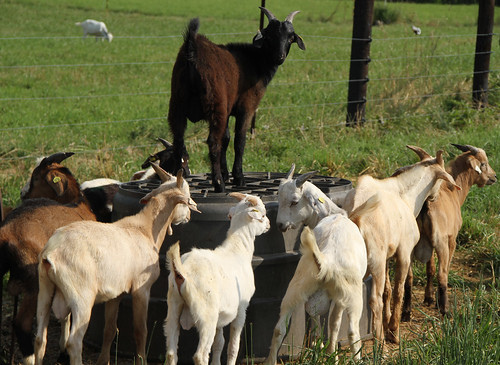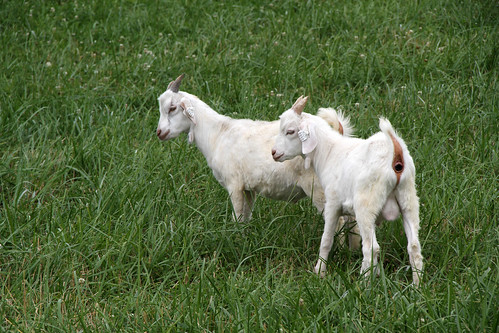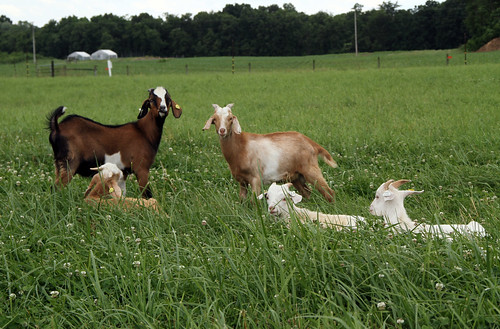Forty-nine bucks started the 2012 Western Maryland Pasture-Based Meat Goat Performance Test on Saturday, June 2.
Prior to being released onto the pasture, the bucks stood in a footbath containing a zinc sulfate solution. The purpose of the foot bathing is to prevent hoof problems.
The goats were weighed; however, the June 2 weight will not serve as the starting weight for the test. Starting weights will be determined on June 14-15, after a 12-day adjustment period. The adjustment period will give the goats time to adjust to their new environment, diet, and herd mates.
Initial weights ranged from 24 to 65 lbs. and averaged 40.0 ±8.32 lbs. (18.2 ±3.8 kg). The median weight was 39 lbs.
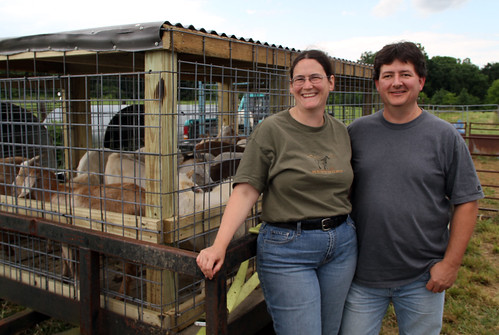 |
Jodie & Randy Majancsik (from Kentucky)
are new consigners to this year's test. |
Fecals and deworming
A fecal sample was collected from the rectum of each goat to determine the goat's initial fecal egg count (FEC). It will be used along with with the sample collected on June 14 to determine the effectiveness of the triple deworming. On June 2, the goats were dewormed with moxidectin (Cydectin drench @ 2 ml/11 lbs), albendazole (Valbazen drench @ 3 ml/50 lbs.) and levamisole (Prohibit drench @ 3 ml/50 lbs.).
The purpose of the triple deworming is to reduce fecal egg counts to as close to zero as possible. For an anthelmintic treatment to be considered effective, fecal egg counts should be reduced by 95 percent or more. By using anthelmintics from each of the drug groups, it is hoped that the triple treatment will achieve this.
A pooled fecal sample was collected from random goats. It will be used for larvae ID. The only way to identify the types of roundworms infecting the goats is to hatch the eggs and identify the worm species from the larvae.
Scoring
While the goats were standing on an elevated platform, their initial FAMACHA©,
body condition, coat condition, dag, and hoof scores were determined.
These scores will always be determined by the same person (Susan
Schoenian) for consistency.
FAMACHA© eye anemia scores range from 1 to 5, where 1 is healthy (no anemia) and 5 is very anemic. In the future, only goats with FAMACHA© scores of 4 or 5 will be dewormed. Goats with FAMACHA© scores of 1 or 2 will not be dewormed unless they present with bottle jaw. Goats with FAMACHA© scores of 3 may or may not be dewormed, depending upon other criteria such as weight loss, body condition score, dag score, etc. On June 2, FAMACHA© scores ranged from 1 to 5 and averaged 2.14 ±0.91.
A scale of 1 to 5 (including half scores) is used to assess body condition scores in small ruminants, with 1 being emaciated, 3 being average, and 5 being obese. On June 2, body condition scores ranged from 1.5 to 3.5 and averaged 2.52 ±0.32. Body condition score is an important indicator of the health and welfare of individual goats.
 |
Dee & David Richhart (from Indiana)
are new consigners to this year's test. |
Coat condition scores are another means to evaluate the health and well-being of individual goats. A poor quality hair coat is often indicative of parasitism and other health problems. External parasites (e.g. lice) can also affect coat condition. The test uses a scale of 1 to 3 (including half scores) to assess coat condition, with 3 being the healthiest coat. On June 2, coat condition scores ranged from 1.5 to 3 and averaged 2.2 ±0.30.
A dag score is indicative of past or current scouring or loose feces (diarrhea). A scale of 0 to 5 is utilized, with 0 being no signs of scours and the higher scores indicating increasingly more soiling of the rear end. While not a symptom of barber pole worm infection, dagginess can be a symptom of other internal parasites, especially coccidia. Few goats had positive dag scores. Dag scores often increase as the goats adjust to their new diet or when the forage is especially wet.
Hoof scores are new for this year. The test is attempting to evaluate hoof growth and abnormalities. Using a scale of 0 to 5, 0 indicates no need for hoof trimming and the higher scores indicate increasingly more hoof growth. Abnormalities (e.g. pockets, abnormal hoof growth, etc.) will also be noted.
Ear tags and soremouth
Each goat was given an ear tag. If the goat had an ear tag in addition to its scrapie tag, this tag was removed and the test tag was inserted into the same hole. For goats that had only a scrapie tag, a new hole was punched in their other ear and the test tag was inserted. The hole punching was done to help prevent ear infections. Existing ear infections were cleaned and sprayed.
The soremouth vaccine was applied to a scarified area under the tail head of each goat. Soremouth vaccination was added to the protocol last year, as in the earlier years of the test, goats that were naive to soremouth were at a disadvantage. Vaccination levels the "playing field."
After being worked, the goats were given access to two acres of cool season grasses (orchardgrass + Max Q tall fescue). For the first five days of the test, the goats will be treated with amprolium (Corid @ 24 oz per 50 gal of drinking water) to prevent coccidiosis.
Special thanks is extended to those consigners (and everyone else) who helped work the goats.
Download initial report 


